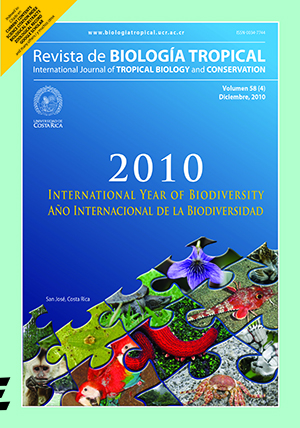Abstract
The fruit-eating bat, Dermanura tolteca, has a broad geographic distribution in Mexico and it is a very important seed dispersal of Neotropical plants. Nonetheless, information on the biology of this bat species is scarce, especially with regard to demography. We studied some ecological aspects and population dynamics of D. tolteca from Southeastern Mexican State of Oaxaca. The study was conducted in a perennial tropical forest, over a period of 80 nights, a sampling effort of 73 200 mist-net-hour, from May 2006 to August 2007. A total of 176 specimens were captured, 98 females and 78 males. Population size was estimated in 237 individuals in the study area, with a greater number during rainy season. The population density of this bat, in its range of distribution in Mexico is low compared to other nose-leaf bats. Captures were correlated with monthly precipitation, and this result may be linked to food resources abundance in tropical and subtropical areas. The reproductive pattern was bimodal polyestrous, with birth periods between August-September and April-June. Greater body mass was observed in females than males. The male-female ratio and age-related demographics were similar to other noseleaf bats. The biological characteristics of D. tolteca are typical of nose-leaf bats of the family Phyllostomidae##plugins.facebook.comentarios##

This work is licensed under a Creative Commons Attribution 4.0 International License.
Copyright (c) 2010 Revista de Biología Tropical
Downloads
Download data is not yet available.






